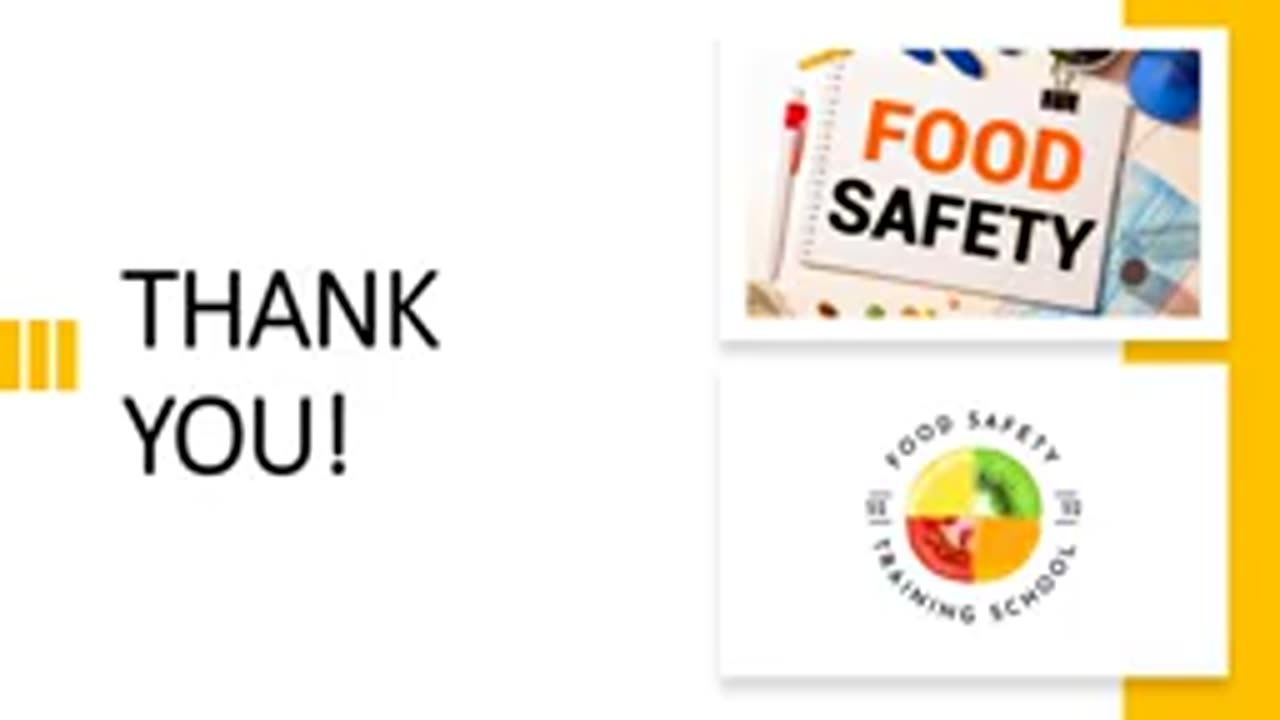Premium Only Content

FAT TOM and Food Safety
### **FAT TOM and Food Safety**
**FAT TOM** is an acronym used to describe the six key factors that affect the growth of **pathogenic microorganisms** (bacteria, viruses, and fungi) in food. Understanding and controlling these factors is critical to ensuring food safety and preventing foodborne illnesses. By managing **FAT TOM**, food handlers and businesses can minimize the risk of contamination and spoilage in food products.
---
### **The 6 Factors in FAT TOM**
1. **F – Food**
- **Definition:** Pathogens require a food source to grow. High-risk foods, especially those that are moist and rich in nutrients, provide a suitable environment for bacteria.
- **Examples:**
- **High-risk foods:** Meat, poultry, seafood, dairy, eggs, cooked rice, and pasta.
- **Low-risk foods:** Dry, preserved foods (e.g., canned foods, dried fruits, and nuts).
- **Food Safety Tip:** Properly store perishable foods in the refrigerator or freezer to limit bacterial growth.
2. **A – Acidity**
- **Definition:** Microorganisms thrive in foods with a neutral or slightly acidic pH (pH 4.6 to 7.5). Acidic foods (pH below 4.6) inhibit bacterial growth.
- **Examples:**
- **Low-acid foods (higher pH):** Meats, poultry, and fish.
- **High-acid foods (lower pH):** Citrus fruits, tomatoes, vinegar, pickles, and fermented products.
- **Food Safety Tip:** Acidic foods are less likely to support pathogen growth, but for low-acid foods, ensure proper storage, cooking, and handling.
3. **T – Time**
- **Definition:** Pathogens need time to grow. The longer food is held in the **danger zone** (between 40°F - 140°F or 4°C - 60°C), the higher the chance for bacteria to multiply.
- **Examples:** Bacteria can double in number every 20 minutes if food is kept at the wrong temperature.
- **Food Safety Tip:** Always minimize the time food is exposed to the danger zone. Use timers or reminders to ensure food is cooked or refrigerated within safe time frames.
4. **T – Temperature**
- **Definition:** Temperature plays a critical role in the growth of pathogens. The "danger zone" for food is between 40°F (4°C) and 140°F (60°C). Below 40°F (4°C), bacteria growth slows down; above 140°F (60°C), it can be killed.
- **Food Safety Tip:** Keep cold foods at 40°F (4°C) or below and hot foods at 140°F (60°C) or above. Always cook food to the recommended internal temperature.
5. **O – Oxygen**
- **Definition:** Some bacteria, like **aerobic bacteria**, need oxygen to grow, while others, like **anaerobic bacteria**, can grow without oxygen.
- **Examples:**
- **Aerobic bacteria**: Grow in foods like fresh fruits and vegetables.
- **Anaerobic bacteria**: Grow in vacuum-sealed packages or canned foods (e.g., Clostridium botulinum, which causes botulism).
- **Food Safety Tip:** Vacuum-seal or can food correctly and store it at proper temperatures to minimize the risk of anaerobic bacteria growth.
6. **M – Moisture**
- **Definition:** Pathogens need moisture to thrive. The amount of available moisture in food is referred to as **water activity (aw)**. Foods with higher water activity provide a better environment for bacterial growth.
- **Examples:**
- **High-moisture foods:** Raw meat, poultry, fish, dairy products.
- **Low-moisture foods:** Dried foods, cured meats, or products with preservatives.
- **Food Safety Tip:** Control moisture levels by using proper drying, canning, or refrigeration techniques to prevent microbial growth.
---
### **How FAT TOM Relates to Food Safety**
By managing **FAT TOM**, food businesses and handlers can prevent foodborne illnesses by limiting conditions favorable to harmful pathogens. Here’s how to control each factor:
- **Control Food:** Keep food fresh and store perishable items correctly.
- **Monitor Acidity:** Understand the pH levels of foods and use acid to prevent microbial growth where appropriate.
- **Limit Time and Temperature Abuse:** Ensure food is not held in the danger zone for too long. Use food thermometers and implement time management practices.
- **Control Oxygen:** Use proper packaging and storage methods for both aerobic and anaerobic microorganisms.
- **Regulate Moisture:** Keep foods with high moisture in refrigeration, or dry and preserve foods as needed to inhibit growth.
By addressing the **FAT TOM** factors, food establishments can reduce the risk of contamination, spoilage, and foodborne illness, ensuring the safety of the food served to customers.
-
 6:54
6:54
HSESafetyInformation
6 months ago6 Must Try Breakfast recipes By Food Fusion
351 -
 LIVE
LIVE
Wayne Allyn Root | WAR Zone
6 hours agoWAR Zone LIVE | 3 SEPTEMBER 2025
130 watching -
 1:28:57
1:28:57
Redacted News
3 hours agoBREAKING! Putin's DEVASTATING news for Europe | Secret UFO Space Base in Huntsville | Redacted Live
85.8K98 -
 1:17:49
1:17:49
vivafrei
5 hours agoEpstein Press Conference DEBACLE! Missing Minute FOUND? Canada Continues to Fall! & MORE!
85.6K64 -
 29:30
29:30
Stephen Gardner
3 hours ago🟢YES! Trump’s Doing It! Ben Shapiro UNLEASHES on Democrat STUPIDITY!
34.4K17 -
 LIVE
LIVE
Dr Disrespect
7 hours ago🔴LIVE - DR DISRESPECT - METAL EDEN - NEW 2025 SCI-FI FPS LAUNCH STREAM
958 watching -
 DVR
DVR
StoneMountain64
5 hours agoBattlefield's Easter Egg Phantom Project is STILL ALIVE
33.9K -
 LIVE
LIVE
LFA TV
12 hours agoLFA TV ALL DAY STREAM - WEDNESDAY 9/3/25
1,033 watching -
 DVR
DVR
freecastle
8 hours agoTAKE UP YOUR CROSS- Love...Light...TRUTH!
14.3K3 -
 1:50:29
1:50:29
The Quartering
5 hours agoEpstein Victims To NAME People, Mutiny Over RFK Jr, Trump Turns On Warp Speed?
139K55